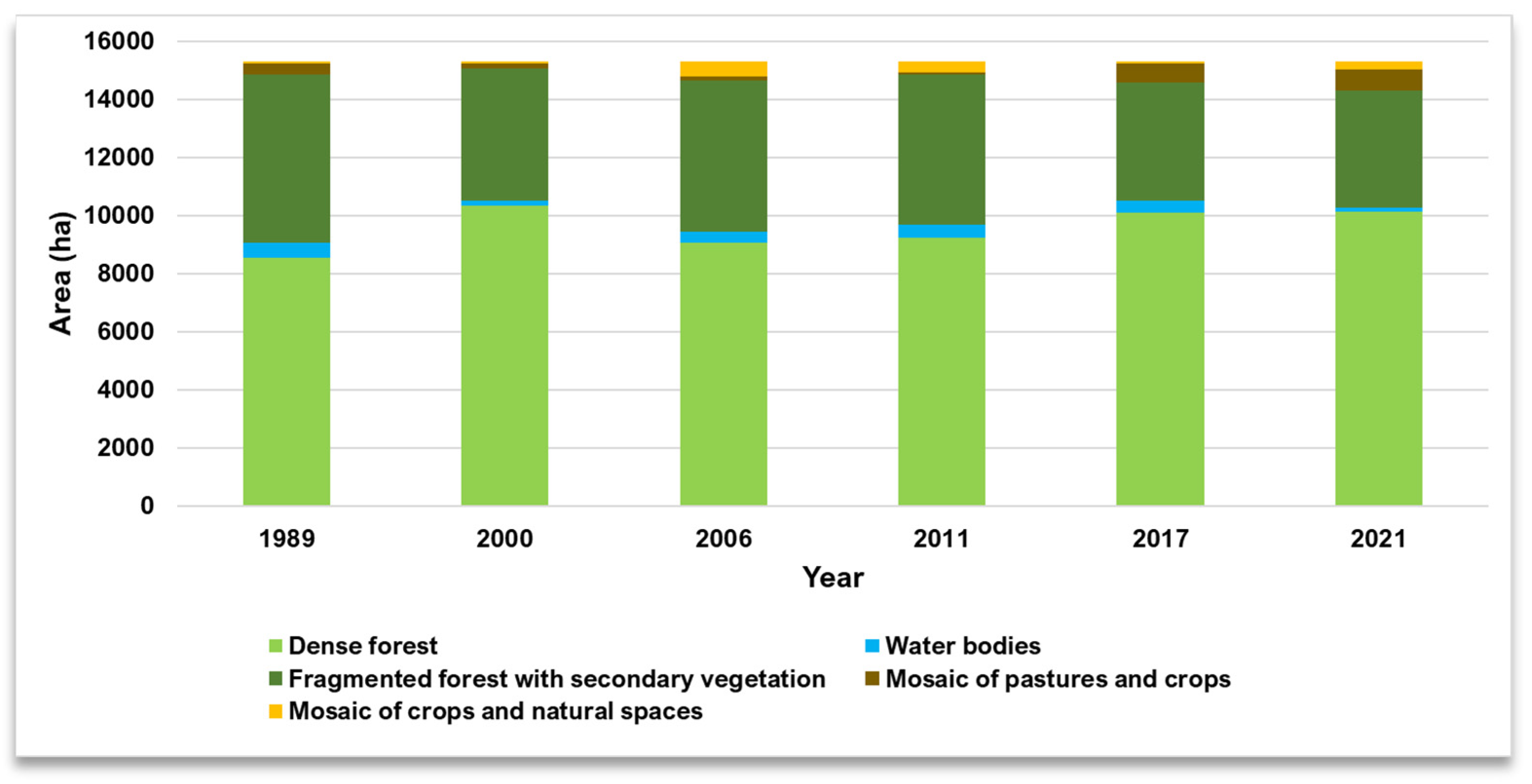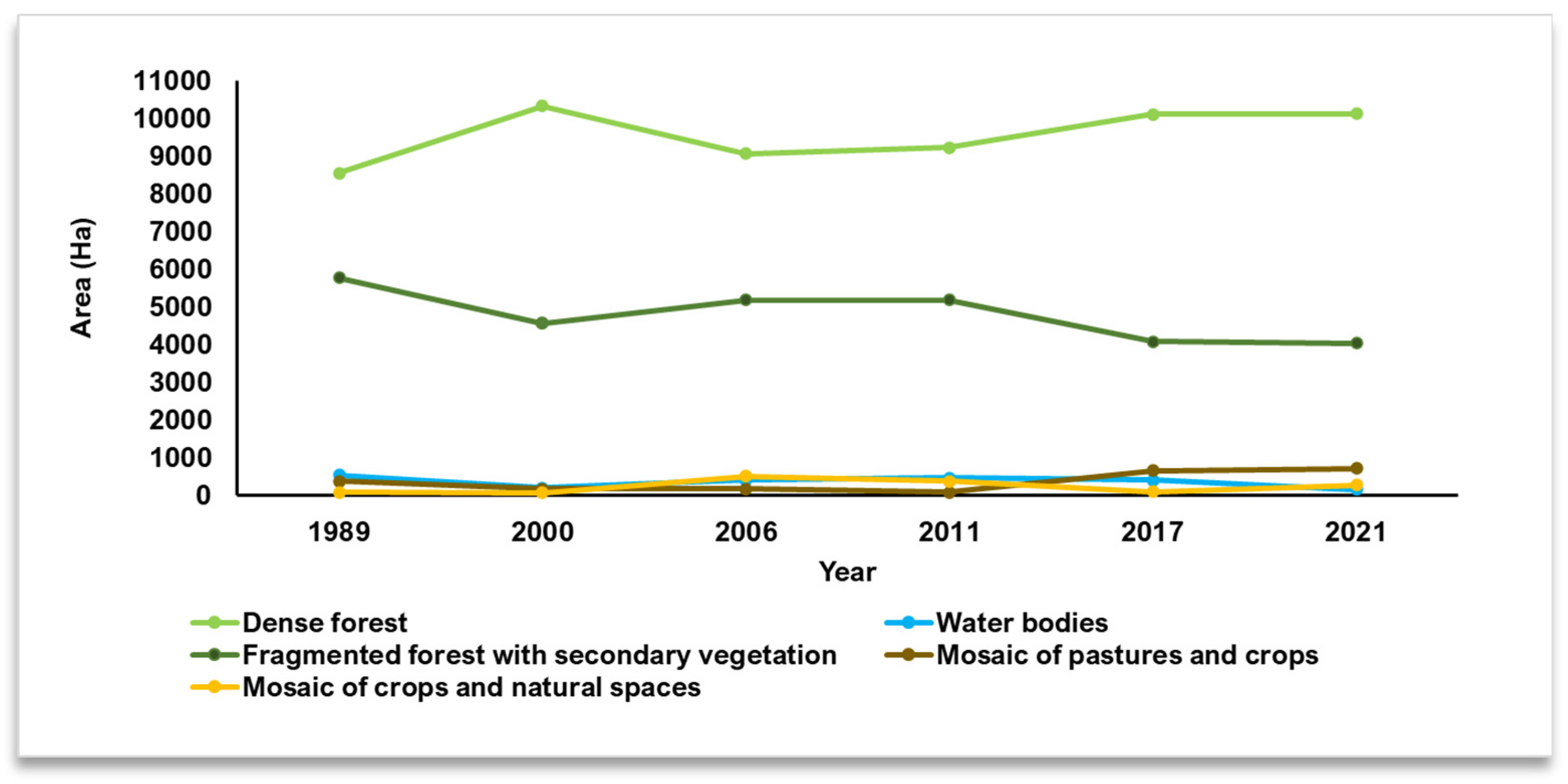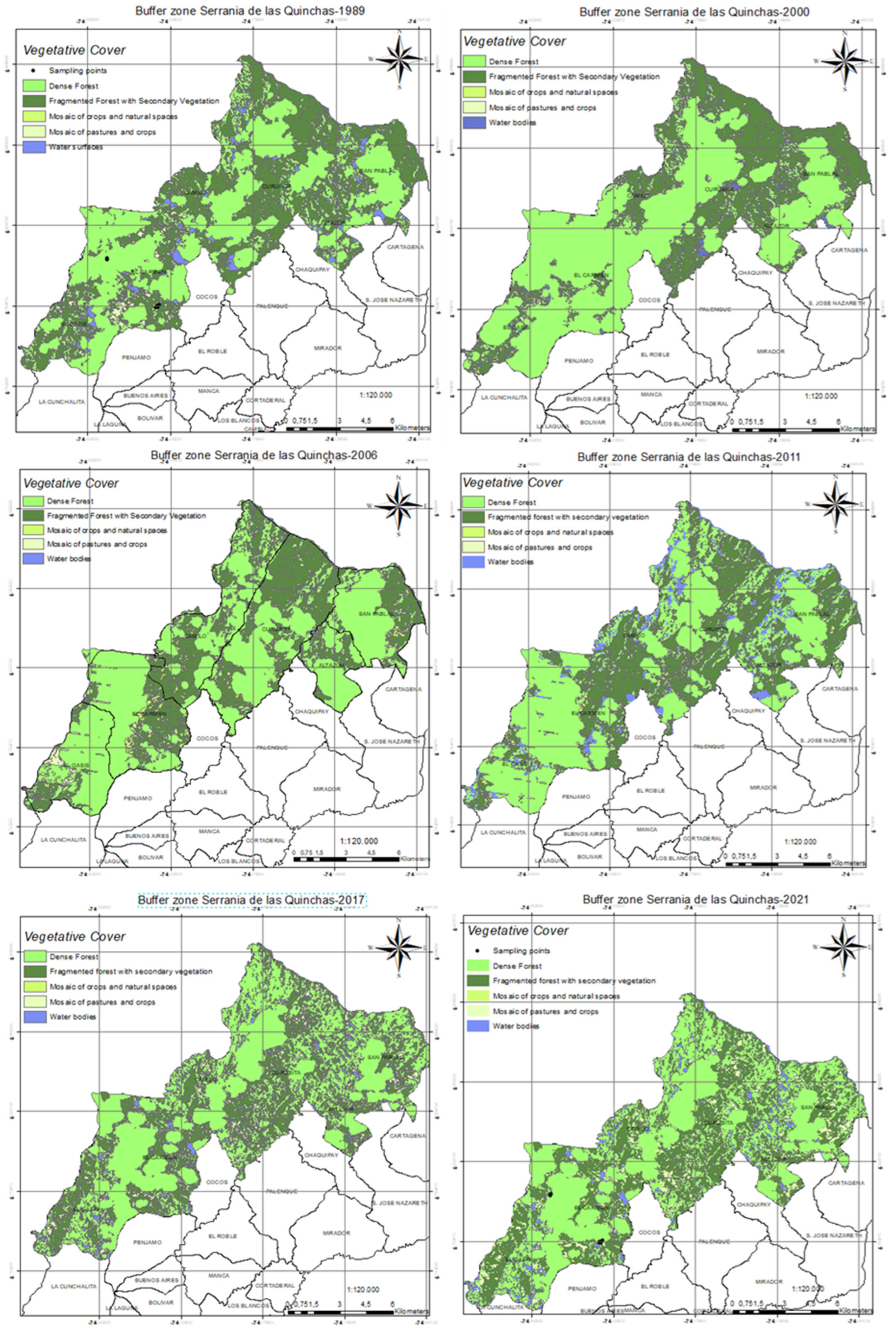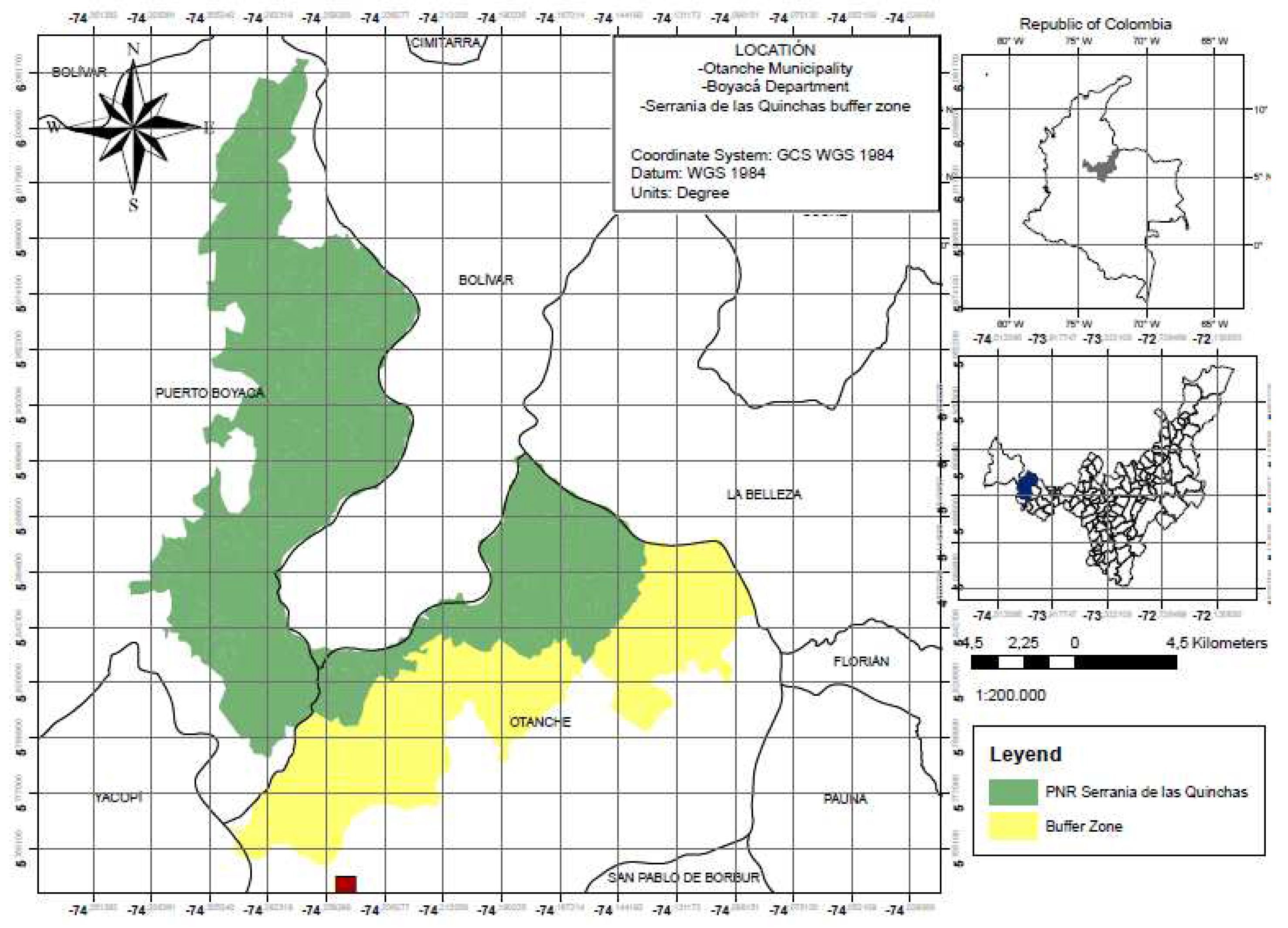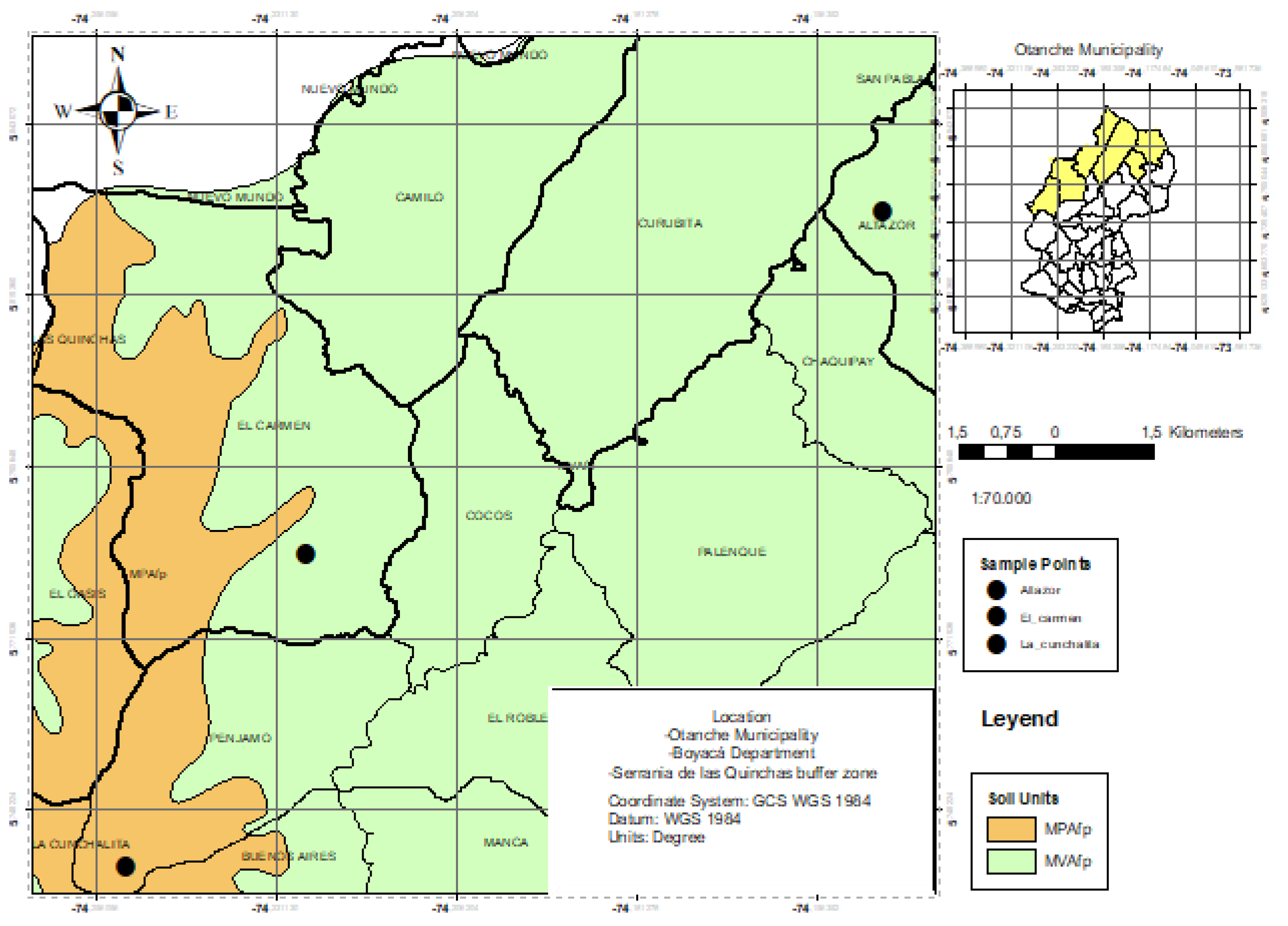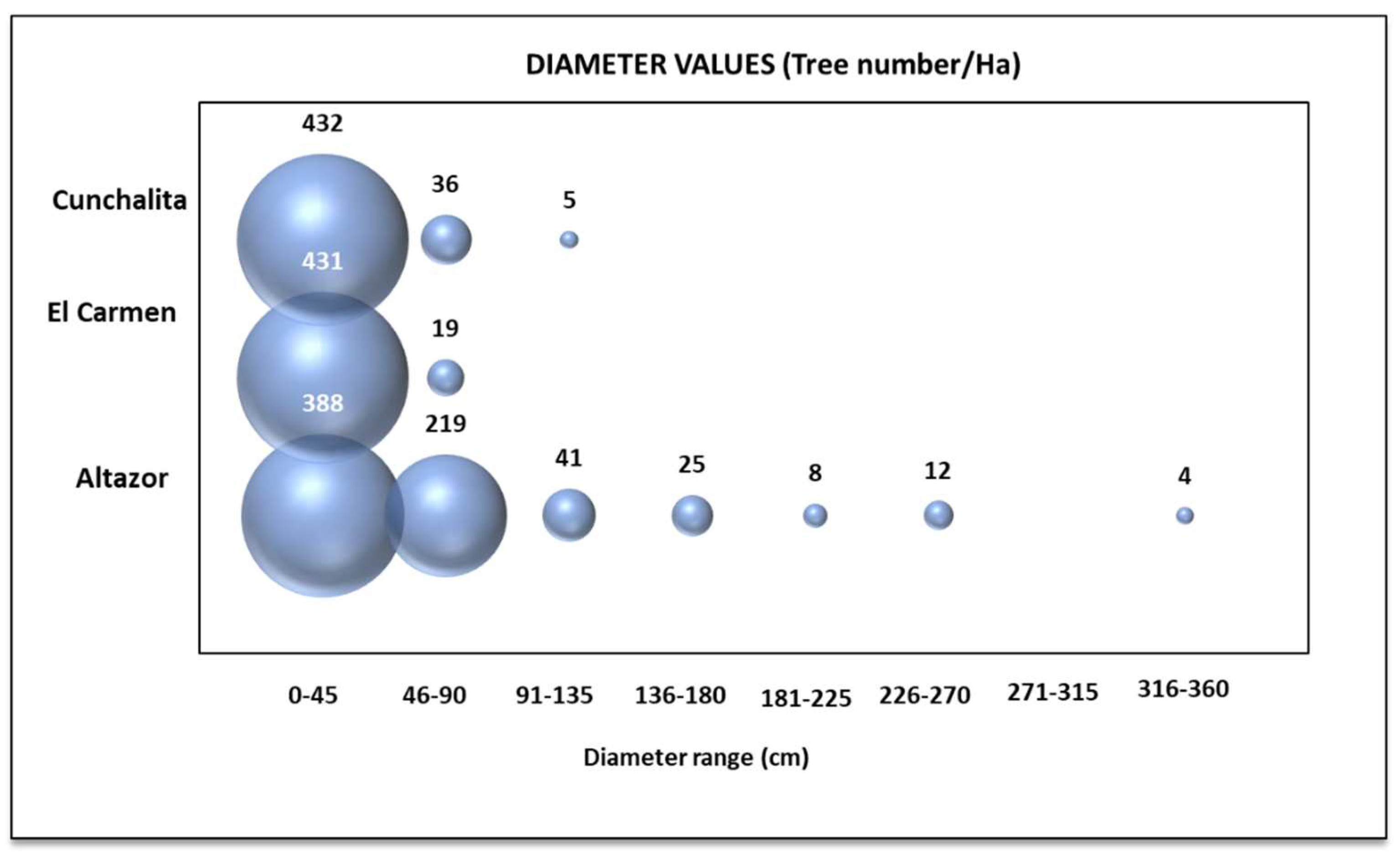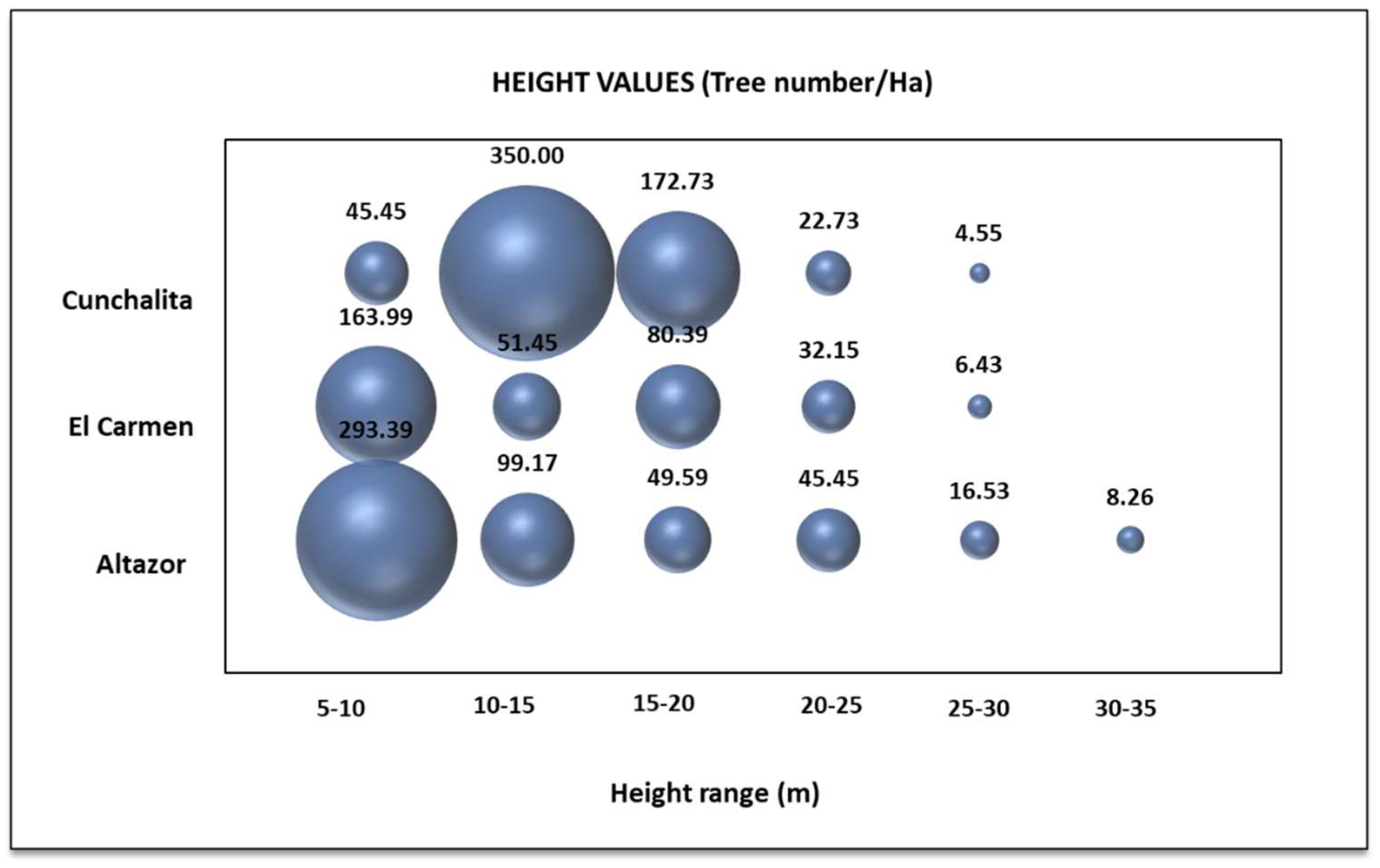1. Introduction
Climate change, attributed to fast CO
2 concentration rise in the atmosphere is one of the main environmental problems that humankind must face towards sustainability. It is caused mainly by fossil fuels use and changes in land use [
1]. Colombia has an extensive coverage of natural forests that represent 52% of the total area of its continental surface, being the third country in South America with the largest area of natural forests. Also, ecosystems related with these forests make this country the second one with the highest biodiversity in the world. However, deforestation is the main problem related to CO
2 capture in this country. In the last two decades, 3.1 million hectares of forest have been deforested in the country. In general, it is estimated that it lost more than 6 million hectares of natural forests due to deforestation from 1990 to 2016 [
2], and for 2022 deforestation rates are growing faster than ever before [
3]. The soil cover in Colombia, was 59% in protected areas, 34% in livestock activities, 5% in agriculture and forestry in a low proportion for 2016 [
2]. According to data from Mapbiomas Colombia [
4], for 2022, Colombia was 58% covered by forest, 13% by a natural area different from forests, 26% by agricultural areas, 1% for no vegetation areas, and 2% by water bodies. The growing livestock and agriculture activities generate conflicts of land use that are reflected in deforestation and deterioration processes of natural forests. Natural forests are one of the main sinks for CO
2, that accumulates in leaves, branches, roots, trunks and soil. This storage usually is a long term one, especially when forests are harvested to make long lasting items such as furniture [
5]. Therefore, forest preservation, reforestation and plantation have been found to be one of the most suitable alternatives for CO
2 sequestration, and its capacity depends on the forest type and its management practices [
1].
Strategies for the Reduction of Emissions due to Deforestation and forest degradation are being formulated under the United Nations Framework Convention on Climate Change (UNFCCC) and are being implemented worldwide. These strategies require territorial governance and enhance knowledge about forest management of ethnic groups and rural communities that live and depend on them. Economic incentives such as CO
2 trading are an opportunity to generate income to local communities that are having problems to find a sustainable way to manage the forests in their territories. But trading CO
2 derived from forest preservation require a detailed knowledge of forests state and its carbon stocks. A way to do it is using Corine Land Cover (CLC) and biomass data to establish how land cover changes affect the carbon stock in vegetation [
6,
7,
8,
9,
10]. In the case of Colombia, some studies have been published showing these changes, most of them using this methodology. A study made by [
9] for forests located at different altitudes in the department of Antioquia, using CLC and biophysical variables measured for sample plots in the region, found that the average aerial biomass was 244 ± 63 Tn/Ha and the deforestation rate in the period 2000-2007 was 25,279 Ha/year for this department. The Colombian Institute of Hydrology, Meteorology and Environmental Studies made a study for estimating carbon content in Colombian forests for 2010 from statistical analysis using information provided by governmental and non-governmental institutions, and national and international researchers, and by different classification systems such as Holdridge Life Zones, Land Cover Classification System, humidity provinces and Colombian ecosystems [
11]. This institute also made an estimation for CO
2 emissions caused by deforestation along the period between 2005-2010 for Colombia. Data was used from several plots along the country and some emission factors from researchers that worked in ecosystems like those from the country [
10]. A different methodology was used by [
12] to estimate carbon stocks in the Colombian amazon forest with high resolution maps and LiDAR samples upscaling it to a large area in the amazon Colombian forest. This study showed that these maps had a 14 % uncertainty at 1 Ha resolution, while regional maps using stratification by CLC methodology had a 28 % uncertainty.
The Serrania de Las Quinchas Regional Natural Park (PNRSQ), located in the municipalities of Puerto Boyacá and Otanche, Colombia, is a protected area with conflicts regarding the change of its vegetation cover. This ecosystem, the last relict of the humid tropical forest of the Middle Magdalena, has followed a pattern of continuous deforestation, reaching an 80% loss of the native forest. Historically, this has been a conflict territory due to the presence of illegal activities, and currently, even though these activities have decreased, social problems persist due to the low income and unemployment of the population. Municipality of Otanche has, for example, a rate of multidimensional poverty of 79.2%, compared to an average of 54.9% in the department of Boyacá where it is located. Nowadays productive and conservation activities are being promoted, among which the development of cocoa cultivation stands out, as well as other crops such as cassava and coffee, livestock, and forest extraction. Other recently developed and potential activities include nature tourism, but it is having only a very marginal development. Currently, the Environmental Management Plan of the PRNSQ has determined a zoning intended for conservation, thanks to its great biological diversity that has led it to be declared a natural park, a Biodiversity Hotspot zone by NASA, and a bird conservation area by the Alexander von Humboldt Institute [
13].
An activity intended for this ecosystem conservation is related to forest conservation and its sustainable management. However, deforestation rates continue at a high-speed due to the lack of income sources related to this activity. An interesting income source has proved to be the carbon sequestration credits, but little information about its potential has been issued at the date. For this, land cover may be used, but it has been shown that few variations of the biomass have been explained by normalized difference vegetation index (NDVI) [
14]. Therefore, more detailed information is needed to estimate Above Ground Biomass (AGB). Currently, in Colombia, a methodology framework to measure biomass was issued by Institute of Hydrology, Meteorology and Environmental Studies (IDEAM), and is based in in situ measurements such as height and diameter, and allometric equations from previous studies made around the world [
15]
Forest stocks have been studied at a country level for the specific areas of Antioquia and Amazonas. Therefore, this study analyzes carbon stock for this unique ecosystem, by using existing and previously applied methodologies adapted to Colombia, adding field measurements of aboveground biomass and carbon soil content. Additionally, temporary change of land cover because of land use conflicts is analyzed and strategies for preservation and generation of income for communities based on ecosystem services are proposed.
2. Materials and Methods
2.1. Study Area
Study area was chosen as the buffer zone for the PNRSQ, in the municipality of Otanche, Boyaca Department, Colombia. A Digital Elevation Model (DEM) was downloaded from the United States Geological Service website, and the delimited area of the environmental management plan of the National Natural Parks of Colombia entity. According to this information, the buffer zone was used as the study area. See
Figure 1.
2.2. Vegetation cover
Multitemporal analysis for land covers was made using satellite images for the years 1989, 2000, 2006, 2011, 2017 and 2021. An atmospheric correction was made using QGIS software tool cloud masking. Normalized Difference Vegetation Index (NDVI), that measures the vegetation cover areas using the near infrared and red light was used. The following equation was applied:
where
NDVI = Normalized Difference Vegetation Index
NIR = Near Infrared intensity
Red= Red intensity
With the calculated NDVI for each cover, Corine Land Cover (CLC) methodology was used to compare and classify vegetation cover properties. Using satellite medium resolution images (Landsat), land cover maps were made at a scale 1:100.000 using ARCGIS software. Subsequently, coverage was confirmed in the field through georeferencing. The classification method used was supervised classification through selection of samples identified in the field.
The area for each CLC vegetation cover for each year was calculated using ARCMAP software. With this information, change in each land cover over the years was calculated using the following equation:
Where:
TCCN = Change rate of land cover over the years (%)
ATC2 = Final Land Cover area in time 2
ATC1 = Initial Land Cover area in time 1
2.3. Vegetation cover change matrix
The identification of vegetation cover changes of the vector layers in the different years was carried out through a series of geoprocessing tools of intersection layers made using ArcGIS Pro software. This series of geoprocessing is useful to analyze changes between rural and urban land, agricultural border expansion, deforestation, or changes between different types of cover, as it was made in the present study [
16].
Vector layers with the Corine Land Cover classification for years 1989, 2000, 2006, 2011, 2017 and 2021 were taken as input layers, and analyzed by taking pairs of years, and thus obtain the global change between the initial year of analysis and the most recent year (1989-2021), as well as the changes between the years 1989-2000, 2000-2006, 2006-2011, 2011-2017 and 2017-2021. From the operations made with these layers, tables were obtained that include the attributes of each shapefile, where the geometric area in hectares was recalculated.
A new comparative field called "Before-After" was created in the attribute table of the layer resulting from the intersection, which carries the information of the name of the coverages to be compared. For this purpose, the "Field calculator" tool was used, where the coverage fields of the couple of years analyzed were concatenated. The symbology was changed to red tones in these coverages where changes were identified between them.
Finally, in order to identify the number of hectares that changed between the different types of cover, a consolidation of the areas was carried out using the "summarize" tool, where the result was a table that shows the number of hectares that changed between the different covers.
2.3. Sample plots
Three sample plots were chosen for measuring biophysical properties in forests in the study area, choosing places located in different mapping units to check differences in species, height, and diameter of the trees due to different soil properties. However, according to [
17], aboveground biomass could also change depending on the forest management, especially if forest has unplanned exploitation. Therefore, care was made in choosing three plots with few human interventions, however, once being there, it was difficult to find a totally preserved area. Evidence of selective deforestation was found almost everywhere, classifying these plots as an intervened primary forest. According to the Colombian protocol for estimating biomass [
17], plots must be chosen in all present cover lands, and in different soil, climate, and altitude conditions. In this research 3 plots of approximately 0.25 Ha each, were chosen. The compartments chosen for carbon estimation were aboveground aerial biomass and soil. Their location is shown in
Figure 2, and properties, in
Table 1:
2.4. Forest biomass estimation
For forest biomass estimation, areas for each land cover determined by CLC methodology as explained in
Section 2.2, were used. Theoretical biomass contents were used based on the correlation and data from [
11,
18]. Also, an average of the carbon stock calculated based on field measurements made in this study was used. For this, the following procedure was followed: The aboveground aerial biomass content for the 3 parcels (section 1.3) was estimated using field measurements by the indirect method calculated by allometric equations reported by [
19]. This method was developed for different life zones, which allow estimating aerial biomass in a wide environmental gradient in Colombian ecosystems. These models were validated with field measurements and nowadays are the best approximation to calculate AGB in Colombian tropical forests. In our study, all the trees with a diameter higher than 10 cm were measured for each parcel. Diameter at chest height, was measured and height was calculated after measuring angles using a clinometer. Biomass was estimated by an allometric equation for tropical humid forests using tree height, diameter, and density measurements, as established by [
19]:
Where:
AGB = Aboveground biomass in kg
D = Diameter at 1.30 cm from the soil, in cm
H = Height of the tree, in m
ρ = Density of the timber in g/cm3
A, B1 = Model parameters for humid tropical forests
After calculating biomass for each tree, all the trees aboveground biomass values were summed, and then multiplied by 0.5 to obtain C content, as established by the IPCC [
20]
2.5. Soil biomass estimation
Due to the soil heterogeneity in the area, different contents of organic carbon could be found at different depths. However, only the first soil layer (30 cm depth) was analyzed. For each plot, a trial pit was made for soil survey, with dimensions of 30 x 100 x 100 cm, and samples were taken with the blast-hole and sent for laboratory analysis of total organic carbon content and pH. Total organic carbon was measured by the of Walkly Black humid combustion method, following the methodology described in [
17]. Total organic carbon content was calculated by the following equation:
Were:
TC = Total carbon content in the soil layer (kg/m2)
T = Soil layer depth (m)
C = Carbon concentration (g/kg)
M = Mass of the analyzed material (kg)
V = Depth Increment Volume (m3) (sample taken)
4. Discussion
Variation in time of the vegetation covers shown in
Figure 3 and
Figure 4 calculated by CLC methodology, showed that for 2021 dense forest area increased 18.5 % since 1989. Fragmented forest with secondary vegetation areas diminished by 30.1% in the same period, and the areas with crops, pastures and natural spaces grew in a 112.4%. Natural primary forests are being preserved and increased by the recovery and consolidation of some forests with secondary vegetation; but also, agricultural areas are growing at the expenses of the secondary forests. This conversion of forests and grasslands to cropland or permanent pasture, is a common activity in the tropics, and one of the main problems for this area [
10]. Previous studies show that Tropical Humid Forests in Colombia were 45.377.140,32 Ha of a total of 60.548.267,97 in 2010; and also, that for 200-2005 the forest area lost by year was 137.000 ha/year, a decrease of 0.3% per year [
10]. For the period 2010-2022 according to MapBiomaps Colombia data, forests areas decreased a total of 3,4%, a 0,28% per year, showing a constant path along the years.
As shown in
Figure 5, although dense forest areas are growing in the PNRSQ buffer area, they are more dispersed, and areas that in 1989 were a continuous of dense forest, now are a mix of dense forest and secondary forest, showing an extracting activity, with posterior recovery, that in some cases recover a state very similar to that of the native forest, but in smaller continuous areas.
On the other hand, the average value for carbon content in aerial biomass for the three parcels was 411,3 Ton C/Ha, a high value compared to all of the reported carbon stock values in the literature for Colombian humid forests. In the study made by [
21], researchers used topographic, climate and remote sensing variables in several points to explain the aerial biomass in Colombia based on field measurements and a correlation made by Random Forest model in R. Their model is based on the premise that there is a sensitivity of the optical reflectance to variations in the structure of the vegetation canopy. The statistical model results showed that Ombrothermal index (IOd3), Average annual rainfall, and mid-infrared band (MODIS MCD43A4 Band 6), were the main variables affecting aerial biomass in the Colombian forests analyzed. They reported the medium carbon content per area in Tn C/Ha by natural regions, and for Andes the reported value was 120 Tn C/Ha. Also reported medium values by the Holdridge life zones; and for Tropical Humid forest the reported value was 131,87 Tn C/Ha. In their report by departments, Boyaca had an average of 114,62 Tn C/Ha. They reported that calculated values by Forest Random model underestimated carbon content for forests with high carbon content. The value reported in their study for tropical humid forests was used to estimate the whole forests carbon content to make these values comparable with other similar studies and have a conservative estimation. Other studies reported lower carbon contents, as 82,5 Ton/Ha reported by [
10] for very humid tropical forests in Colombia; 113,45 Ton/Ha reported by [
22] as the total mean value for the forests of the entire country, higher values as 273,1 ±9.8 Tn/Ha have been reported for Colombian Amazon forest [
23].
Cunchalita parcel carbon aerial biomass content is according to values reported in the literature for humid tropical forests in Colombia and El Carmen had a lower carbon content. By the other hand, Altazor parcel had a very high carbon content (1023 Ton/Ha)7 times the average for tropical humid forests in Colombia, showing that this forest is into the category of very well-preserved forests in this area, and that the potential for carbon sequestration in this ecosystem is very high.
These differences in carbon content in aerial biomass in the chosen parcels show the need of using larger sample sizes and a larger number of them in aleatory chosen places to properly achieve a statistical representativity of the forests present in the area, as in other studies such as the study made by [
22]. Results obtained in this research are not conclusive of the carbon content in dense forests, even less when very high values were obtained compared to those reported in the literature for humid tropical forests. Consensus exist about the uncertainty of the remote sensing estimates of vegetation covers to estimate carbon losses in forests, and that ground methods are needed to achieve a higher accuracy [
24]. It is important to note that in all the studies made relating AGB, the main variable influencing accuracy is related to the choice of data type, the stage of the plant growth and structure related to species and environmental conditions [
25]. Important fluctuations in temperature, solar radiation and atmospheric pressure, all of them strongly related to altitudinal variations [
26], then altitude is another variable to take into account. In the same way, it has been suggested by some authors the need of improvement of the existing allometric models, in order to get less uncertainty in the estimation of carbon storage in tropical humid forests. Recent studies show that developments using unoccupied aerial vehicle (UAV) images have shown their capability for delivering accurate measurements with a high correlation between biomass and individual’s height in forest and no forest systems. However, the methods are starting to be known, being very promising for cases like this, in which accessibility to the forests for direct measures is difficult and expensive [
14,
27,
28].
On the other hand, sometimes carbon content in forests soils, could be higher than carbon in AGB, and in the case of tropical forests, this content could be up to 2-3 times the AGB carbon content. In this study, an average of 897,19 Ton carbon/Ha was obtained, 2,2 times that of aerial biomass, confirming this fact. The necessity of taking into account the carbon content is forest soils in this case is mandatory because of its high value. For comparison, carbon soil content in Brazilian amazon forests are between 105 and 127 Ton/ha, 8 times less than the value measured in this study [
29]
Global potential for carbon storage in forests strategies are oriented mainly to existing forests that must be allowed to recover (61%); and the remaining (39%) are for forests that had been fragmented [
24]. In general, CO
2 flux from the atmosphere towards earth is mainly related to photosynthesis processes. This flux depends on variables related to the tree or plant´s type, hydrology, mineralization, nutrients availability, and solar radiation [
1]. Other variables are related to human activities, such as harvesting, nutrients deposition and fires. A strategy for forest management for CO
2 sequestration that considers all its life cycle, implies the use of timber in durable products instead of using wood for energy generation purposes. In this way, CO
2 sequestration is guaranteed for long periods. [
3]. In this way, promoting secondary forest promotion or plantation on degraded forests or lands used for agriculture or pastures generates high CO
2 capture values [
1]. This strategy is commonly known as the Carbon Storage Model. In PNRSQ, wood harvest is made of native species for use mainly to make furniture, but this activity is not legal, measured or planned. Another strategy for CO
2 sequestration is the carbon substitution model in which uncovered lands are covered with forests that later are harvested to generate fuel in the way of biochar or wood pellets, to replace CO
2 emissions from conventional fossil fuels.
However, forests recovery must be primarily be related to a biodiversity positive effect, and has to do with complex local social, political and economic conditions. As proposed by [
24], considering the global assessment for the forests’ potential for carbon sequestration, strategies must consider sustainable practices that consider in the first place the local communities. Among these strategies are agroforestry, silviculture or permaculture practices. In Colombia the signing of the peace agreement with FARC in 2016, gave a rise in deforestation that on some areas was as ahigh a 40%, due to the opening of opportunities for resources appropriation in forests where FARC guerrillas had their shelter [
30]. IN PNRSQ buffer area, dense forest areas were almost the same in this period, but they were more dispersed after 2017. Proposed strategies for this area to limit the illegal wood harvesting include the implementation of cacao crops in agroforestry arrangements, the implementation of efficient silvopastoral systems, as well as the promotion of ecotourism. To this end, an alliance called Alianza Quinchas is made up of governmental and non-governmental entities, community organizations, private companies and academia [
13]. With this alliance stakeholders are searching more governability, improvement of the social structure, increase in the sustainability and efficiency of productive systems, and adequate land use planning. This study is a basis for the generation of specific strategies aimed at the conservation of this important area, a biodiversity hot spot, and as seen in the results obtained, with a high potential for carbon sequestration due to its unique characteristics.

